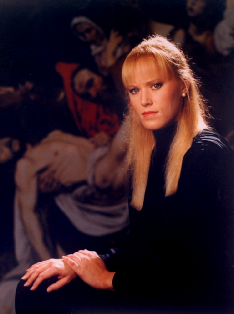


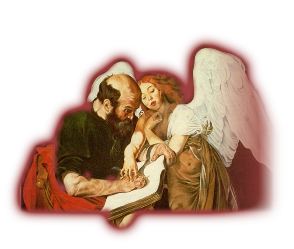

The Ressurection of Matthew and the Angel
Reviving Lost Art -
Digital Masterpieces
Great fanfare was given (and deservedly so) to Factum-
Rewind the clock back 30 years.
Hardly any of today's technology was available for use in reproducing such a refined level of art short of matching paint formulas, badger hair brushes and palette knives used in an era of the masters, 400 years ago. Even hoping to reflect accurately, the 'feel' and character of a master, with close attention to a refine deft touch and matching brush stroke application, separates a resplendent creation from the mundane. Authenticity is another subject where spectral analysis, X-
Matching a master with that 'fine finishing touch' is a challenge. The quality of a reproduction without the original references takes research to almost “trial by ordeal” in gathering information.
Old School -
Noel contacted the state museum organization, Prussian Cultural Heritage (Staatlich Museen
Preussischer Kulturbesitz) inquiring about any information on obtaining a color photo, artist's copy or transparency of the Caravaggio's first rendition “Matthew and the Angle” created prior to its destruction. That original Caravaggio Painting in question was destroyed in 1945 by the allied bombing of the Kaiser-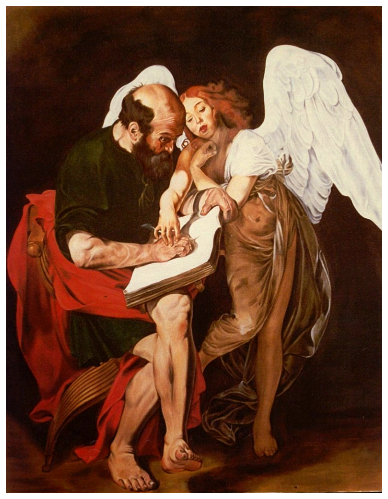
Dr. Erich Schleier a museum director, had remarked in a letter to her that nothing in color was available but it was known and that there were a few photos in black and white possibly still available from the Staatliche Museen zu Berlin in The German Democratic Republic (East Germany)
The Staatliche Museen zu Berlin – Kaiser-
Research indicates that Noel may have indeed been the first person to faithfully recreated the Caravaggio with the best possible descriptive input available, in color. You may see the description in German and translation in letters to Noel, supplied by the museum.
Letters -
The Details
The photographic glass plate had a crack in a corner that can be seen (right image) – The resolution is so precise, by looking carefully, the actual individual strands of hair can be seen on Mathew as well as an undulating wave of craquelure finish reflecting the rippling age of the underlying canvas weave. The finest detail of the feathers in the angel wings are stunning and very explicit.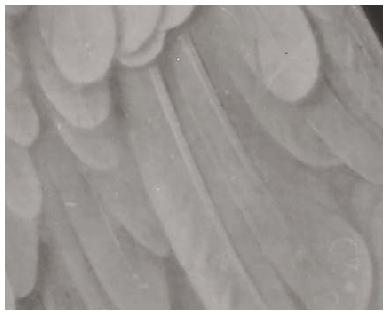
With that information and experience in studying Caravaggio’s 3-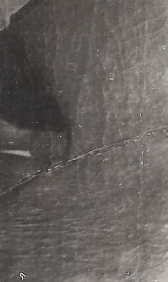 The only controversy in the faithful color reproduction is the exact color of the angel's hair. That color was never described. Color referencing other angels Caravaggio had painted, a medium light mahogany brown was applied. Matthew and the Angel second version was influential in this decision. The photo sensitivity to certain light frequencies in old black and white panchromatic film actual gives a clue to color selection when colors like red reflect and create more density in the captured image rather than the older orthochromatic material. Early films with varying degrees of sensitivity prior to the refinement of Panchromatic film gave a wide range of results like rendering darker complexions in the faces of the people in mid 19 th century scenes. German film makers like Perutz pioneered early sensitized Panchromatic plates as early as 1902. Information on the back of the photo indicates the photo plate could have been used up until 1938. A museum or similar institution would certainly acquire the best material that was available for documentation.
The only controversy in the faithful color reproduction is the exact color of the angel's hair. That color was never described. Color referencing other angels Caravaggio had painted, a medium light mahogany brown was applied. Matthew and the Angel second version was influential in this decision. The photo sensitivity to certain light frequencies in old black and white panchromatic film actual gives a clue to color selection when colors like red reflect and create more density in the captured image rather than the older orthochromatic material. Early films with varying degrees of sensitivity prior to the refinement of Panchromatic film gave a wide range of results like rendering darker complexions in the faces of the people in mid 19 th century scenes. German film makers like Perutz pioneered early sensitized Panchromatic plates as early as 1902. Information on the back of the photo indicates the photo plate could have been used up until 1938. A museum or similar institution would certainly acquire the best material that was available for documentation.
The color reproduction of Caravaggio’s Matthew and the Angel is now hanging in an Oil Company executive’s home. A photo of the painting in situ is shown.
The Nativity Painting for the Oratorio
The same effort to reproduce the Nativity scene (stolen from the Oratorio in 1969) was done very carefully, though certainly not with the technical tenacity of Factum Arte's campaign. Noel's Nativity painting was however, so well executed that an Italian museum curator working with Cultural Representative of the Italian Government Consul in Los Angeles felt that it was the best quality reproduction they had ever seen. The painting had to have the blessings of the Italian Government before it could be delivered to the Archdiocese in Palermo. It took over two years to gain permission from the Church and the Government to execute the painting.
The painting was to be hung just after Christmas in 1986. It may have been hanging temporarily for a very short time because the Oratorio was scheduled to be renovated shortly thereafter and it may have been taken down to protect it. It has not been seen since. 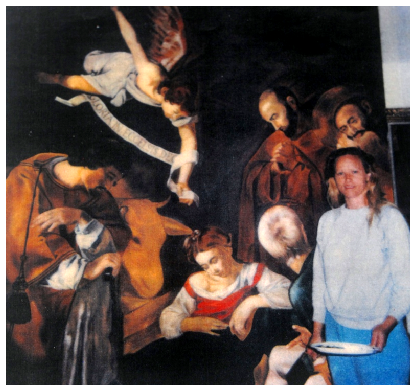
Efforts by Noel or by Factum Arte and SKY ARTE to replace a national treasure are commendable. It is a shame how strangely such an early effort goes so unrecognized with all the pre-
With the limited sources of information, photographs and technology then available 30 years ago, producing an extraordinary likeness to the original is remarkable. Certification by Italian authorities both in the Italian Government and Church is documented in writing has never been questioned. Years of study and understanding the art of Caravaggio, his style and techniques went into the fine rendition of a painting that now has inexplicably disappeared..
Technological triumph is shared through two efforts to return the memory of the original Caravaggio creation lost to greed. The first effort was, for some unknown reason, never realized and displayed. Possibly greed, jealousy or even political pressure was the cause for its disappearance. The second effort was a scientific compilation marvel that was 30 years too late. Some may feel its a bit disingenuous and cold to fill the open frame that once held one of the last masterpieces of Caravaggio with a digitally produced image that reflects a near obsessive need to be as perfect as the original. However the need to see something fulfill a Caravaggio legacy finally gave closure to the citizen of Palermo.
Possibly Noel Baron's first hand created reproduction was too heart felt. Both reproductions were most likely outstanding examples of each era. Both efforts honoring Caravaggio is one thing that is done in charitable spirit, but the course of events will make many wonder what actually prevented it from happening 30 years ago. Had the Archdiocese done as promised, the gift would have possibly made an impact on Italians as did the recent Factum Arte presentation.
Final Word – Artistic License
Simply, through studying any varied applications in painting in general requires many levels of keen observation if an intended reproduction copy is a goal. Many “styles” include understanding the artist’s work by dynamic scale comparisons such as the carefree splash of pigment or a refined single brush hair application in a royal portrait.
Understanding and identifying technique attributed to an artist is important in authenticating art of unknown origin as any museum, dealer, historian or auction house expert will tell you. Artistic drippings of Jackson Pollok “hands off” the canvas style take a unique perspective when connecting to the canvas. We may gave solace the the fact that however any human connection to our art is reflected with pride; the passion we revere in our personal tactile ‘hands on’ connection to that art has always been the gnawing quest for ultimate perfection.
Ironically, the true and ultimate “artistic license” is reflected in the revelation that Leonardo Da Vinci employed his fingertips as maybe an intentional, personal 'final touch of perfection' to his ceations. Many painters use there hands and finger tips in working paint sometimes without a brush. Through serendipity we are however, blessed (using optical scanning technology) with discovering at least three known finger prints Davinci unknowingly left behind in his work. Of the three, the last finger print was responsible for correctly identifying a portrait of a woman “La Bella Principessa”. The small portrait, thought to be a 19th century work, now re-
Caravaggio most likely died poor yet left behind gifts of incompomprable value. What price glory? Beyond essential need, we say the monetary value of most things is based on how much someone is willing to pay. You might say based on supply and demand. Water is a commodity in its own class and usually accessable. However, two days lost on a desert, a canteen full of water becomes priceless. Since the theft of the Nativity painting in 1969, there has been a lot of blood, sweat and tears to maintain his legacy. Many of us have tried to replace and restore the losses that have incurred throgh criminal intent and war. I am certain now Caravaggio, though honored, would have wept if he knew we held him in such high esteam. Those are some expensive tears.
###
NOEL BARON 1952 -

